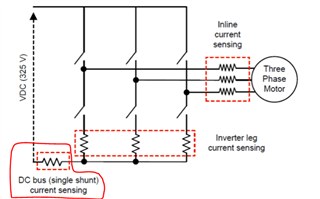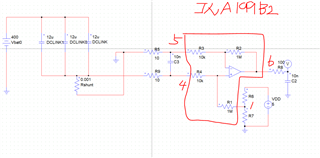Other Parts Discussed in Thread: TMCS1123
Hi,
I would like to inquire about INA199B2 Current Monitoring usage.
What is the difference between current sensing and DC bus sensing through a typical Opamp?

Please review the schematic.

This thread has been locked.
If you have a related question, please click the "Ask a related question" button in the top right corner. The newly created question will be automatically linked to this question.
Hello Valued Engineer,
I am looking at your post and will respond promptly.
Sincerely,
Peter
Hello,
The main differences between a current sense amplifier (CSA) (e.g., INA199) and an operation amplifier in a differential network is that the current sense amplifier will usually have a bias network in between IN+ and IN- pins. This network presents itself has a low differential input resistance (~2.5kΩ) and thus the circuit is not high input impedance like an op amp. The bias network allows CSA to operate on the high-side of the bus, which is primary advantage over the op amp; however, for a 400V bus you would mostly need a hall-effect based current sense (e.g., TMCS1123).
The other primary advantage for the CSA is that the resistor network are precisely matched (usually much less than 1%) and designed with low drift. Gain error is final tested and screened while allowing designer to be more confident in the total circuit error over high population of system. With building a discrete circuit, you have to pay more to get accurate resistors with low temperature coefficients, not to mention use more PCB area.
Sincerely,
Peter